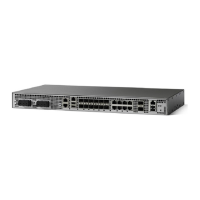t1 <t1_number> cem-group < cem-group-no> unframed
t1 <t1_number> clock source recovered <clock-id>
enable
Verifying ACR in Mode CT3 for SAToP
Verifying ACR Configuration
Router# show running-config | section 0/4/0
controller MediaType 0/4/0
mode sonet
controller SONET 0/4/0
rate OC48
no ais-shut
framing sonet
clock source internal
!
sts-1 1
clock source internal
mode ct3
t3 framing c-bit
t1 1 clock source Recovered 10
t1 1 framing unframed
t1 1 cem-group 1 unframed
interface CEM0/4/0
no ip address
cem 1
!
Verifying Recovered Clock
show recovered-clock
Recovered clock status for subslot 0/3
----------------------------------------
Clock Type Mode CEM Status Frequency Offset(ppb) Circuit-No
0 OCx-ds1 ADAPTIVE 0 ACQUIRED n/a 0/1/1
(Port/t3/t1)
show running-config | section recovered-clock 0 4
recovered-clock 0 4
clock recovered 10 adaptive cem 1 0
Differential Clock Recovery (DCR)
Differential Clock Recovery (DCR) is another technique used for Circuit Emulation (CEM) to recover clocks
based on the difference between PE clocks. TDM clock frequency are tuned to receive differential timing
messages from the sending end to the receiving end. A traceable clock is used at each end, which ensures the
recovered clock is not affected by packet transfer.
1-Port OC-192 or 8-Port Low Rate CEM Interface Module Configuration Guide, Cisco IOS XE Everest 16.7.x
(Cisco ASR 900 Series)
140
Clock Recovery System for SAToP
Configuring ACR for OCn

